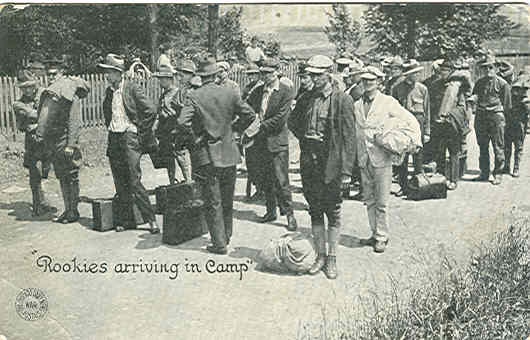
Chapter 6. 1917 to 1919: The First World War Years
ďJohn Ullian and Linda Ferraro: Roots and Legacy www.Ullian.org March 2018Ē
Although this image of draftees
for WWI could seem to show John Ullian, the likelihood is slim.
But there is some resemblance of the man dressed in white to John Ullian if you
squint.
In any case, this is the sort of scene John would have encountered when reporting to Camp Logan in Houston Texas.

Summary
John Ullian entered the U.S. Army on 3 Oct 1917. His unit, the 129
th Infantry of the 33rd Division of the U.S. Army, originated as the 3rd Illinois National Guard, then became the 3rd Illinois Infantry. After being mustered on 28 Jul 1917 it became the 129th Infantry. Following basic training at Camp Logan in Houston TX the unit left on 2 May 1918 for France and 12 months of overseas duty.In 1918 his unit took part in the following major European offensives, all in France:
7 Jul - 5 Aug: Amiens (Picardy);
8 Aug - 20 Aug: Somme;
8 Sep - 25 Sep: Verdun-Fromerville (Lorraine);
26 Sep - 21 Oct: Meuse-Argonne;
26 Oct - 11 Nov: Troyon (Lorraine).
Camp Logan was established on the site of a former National Guard camp just west of Houston that was leased from Houstonís prosperous Hogg family. Construction began on 14 Jul 1917, and the camp closed on 20 Mar 1919. The city of Houston purchased the site from the Hoggs in 1925 to develop it into what is today Memorial Park.
To John, Houston became more than a training site for his Army service. At some point, probably between about 1933 and 1936, he would return to Houston to work as a landscaper prior to his permanent return to Illinois.
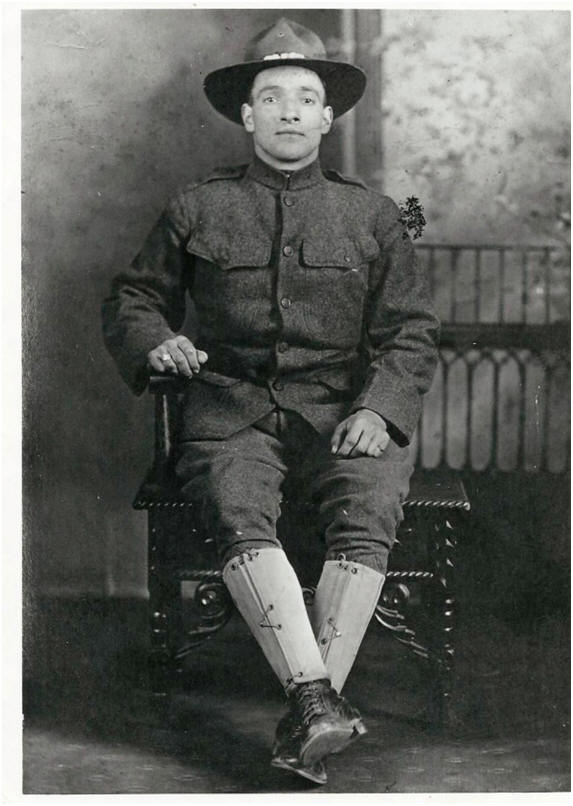
Private John Ullian in his Army Uniform
We have four sets of documentation of Johnís military service: Navy ship passenger lists, documents regarding Johnís being missing from his unit, medical records at the time of his discharge, and certification that he served and was honorably discharged.
Ship passenger lists from the Navy show John as a passenger to Europe and back during the war. The passenger list of the
S.S. Covington sailing from Hoboken NJ on 10 May 1918 lists John with his unit, Company C of the 129th Infantry. It shows his emergency contact as his father [actually his brother] Romano Ullian, 1530 Daen St., Ravina Illinois.
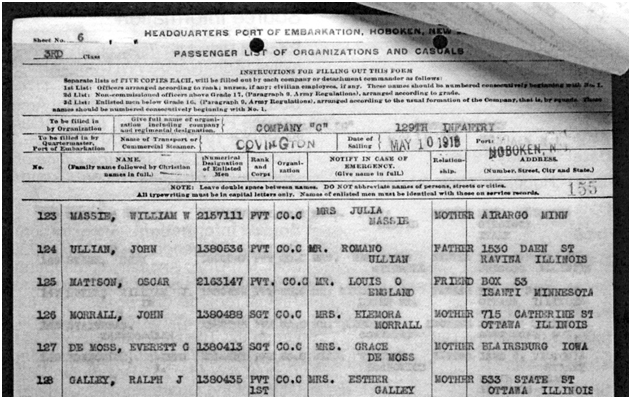
Pvt. John Ullian Listed on the
S. S. Covington, Departing from Hoboken [From Ancestry.com]
The passenger list for the
S.S. Plattsburg sailing from Brest, France, on 7 May 1919 to Hoboken NJ en route to Camp Merritt includes John, with the emergency contact listed as his brother Romano Ullian of Ravinia [Ravina] Illinois. This trip he is not with his own unit, the 129th Infantry. The heading at the top of the list reads "ENLISTED MEN AUTHORITY CS SOS AEF WALKING CASES REQUIRING NO DRESSING CLASS ĎBí" Ė i.e., he returned to the U.S. with other soldiers being transported separately for medical reasons.
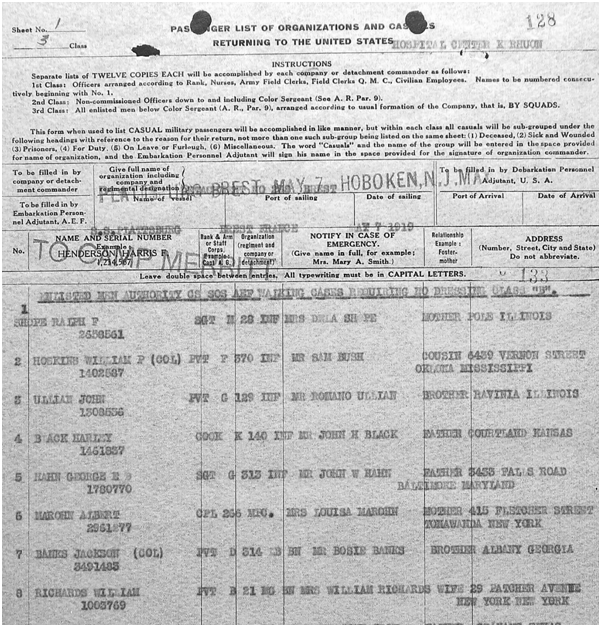
Pvt. John Ullian Listed on the
S. S. Plattsburg, Departing from Brest for Hoboken
Documentation from mid-August 1918 shows that John had been missing from his
unit since before July 8 and was "apprehended" by another unit in the north of
France, near the Belgian border. The reports indicated that they were having
difficulty getting him back to his unit (with a guard to escort him). Locating
his unit seemed to be difficult, given that his unit was on the move.
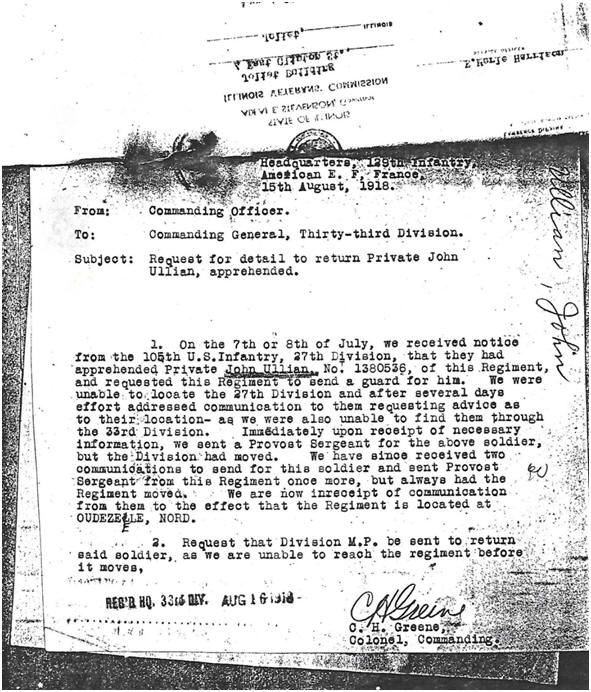
The third set of documents is from his clinical medical record at the Camp Grant base hospital in Rockford IL. He was admitted there on 23 May 1919, immediately prior to his discharge on 27 May. Evidently the purpose of the visit was to establish his health status at discharge.
A selection of the more interesting information from the record follows. His home address is Ravina IL. His nearest relative is his brother Romano. Disposition is to the 161
st Depot Brigade. [Note: depot brigades had the dual missions of receiving recruits/draftees and preparing them for the service, and of receiving soldiers returning from war and processing them through their discharge.] Final diagnosis: No disease found. Recovered. History of present disease: Gassed 28 Sep 1918. (The diagnosis of the ward surgeon in these notes says that he was gassed 22 Sep 1918 to 5 Oct 1918) in Argonne Forest, acute bronchitis followed 13 Dec 1918. Sent to Base 51 Toul, France; then to Base 65, Nantes, France; then to Evac 216, Nantes, France; then to Brest, France; then to Camp Merritt; and finally to Camp Grant. Patient says he does not cough and feels well. No complaints. Family/Personal history: Landscape contractor; abstains from alcohol, father accidental death at 63, mother dead of meningitis at 57; no gunshot wounds or other casualties. 143 pounds, well-nourished.The finding of "no gunshot wounds or other casualties" is not consistent with Johnís telling his grandson David U. Larson that he was bayonetted by a German soldier in combat and showing David an obvious scar on his upper arm. Documentary evidence of the existence of the scar (although not its time or place of origin) exists in Johnís registration for the draft on 27 Apr 1942, which said he had a "Scar on left upper arm."
Another inconsistency in this medical record is that it reported that "M
[mother] dead age 57" and "F [father] dead age 63" but John listed his mother as his nearest relative in Italy when he immigrated. [We are assuming that the doctor was using the letters M and F for Mother and Father, not Male and Female.] His mother was born in 1846, his father was born in 1845, John was born in 1890, and John immigrated in 1908. If she had died at age 57, she would have died in 1903, when John was 13 years old, and before he left Italy Ė thus either she did not die at age 57 or John listed his dead mother as his nearest relative in Italy. We have no other information on when Johnís parents died. We believe that the doctorís report was incorrect. The information on his motherís age at her death had to have been provided by John to the doctor Ė perhaps the doctor mis-heard Johnís response to the question, or mis-read his writing if the question was asked on paper rather than in person. We are assuming, of course, that John knew how old his mother was when she died Ė generally a safe assumption, but an assumption still. If the doctor transposed the ages, with Johnís mother dying at age 63 and his father dying at age 57, then his mother would have died in 1909, the year after he left Italy, and his father would have died in 1903. This transposition would explain Johnís listing his mother on the ship manifest as his nearest relative in Italy.
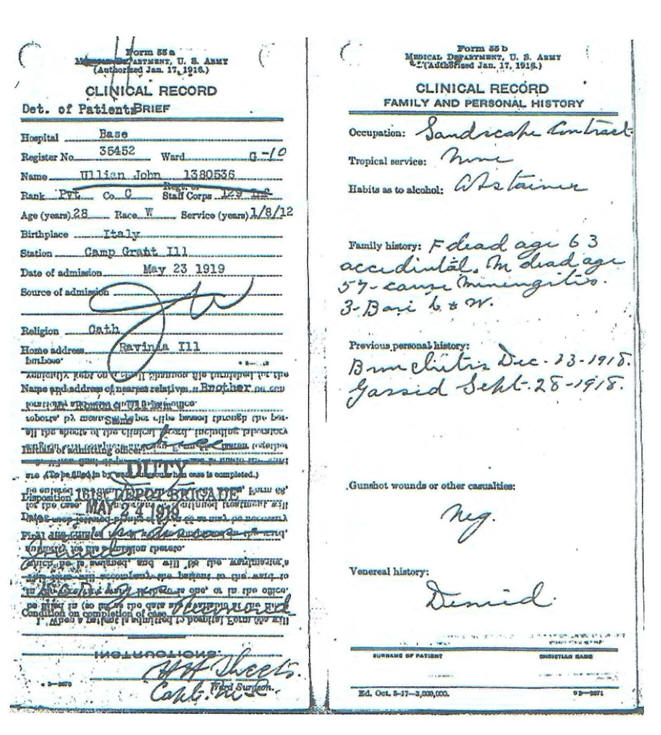
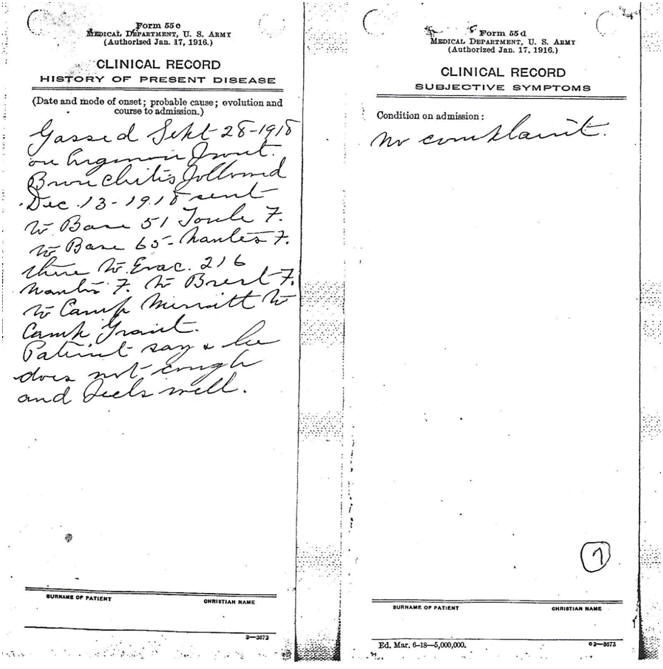
It may be significant in his life that John received his discharge at Camp Grant in Rockford IL. Rockford later became the home of Linda Ferraro, whom John would marry on 7 Dec 1920 Ė about 19 months after his discharge, and about 5 weeks after her arrival in the U.S.
On 28 Aug 1951, John requested a copy of his honorable discharge certificate to replace the original which was lost.
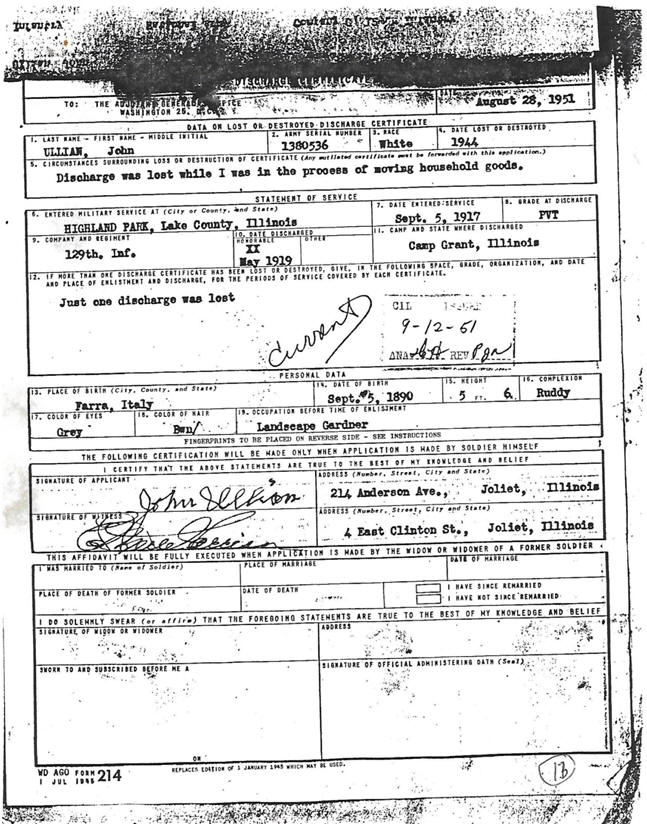
We do not have a copy of the discharge certificate he received as a result of his 1951 request, but shown below is a "Certification of Military Service" received by a family member in 1999. It shows that he was a Private in the Army from 3 Oct 1917 until 27 May 1919 and received an Honorable Discharge.
